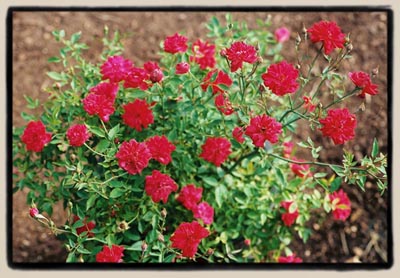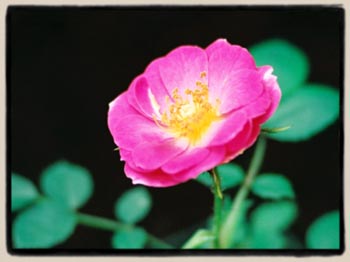 |
|
Albas |
Welcome
to the April 2001 edition of my web site! The roses I write about are
the Old Garden Roses and select shrub and miniature roses of the 20th
century.
For tips on rose culture, pruning, propagation and history, see "Other
resources on this site". To return to this page, click on the
"thorn icon" in the margin at left. Articles from the previous
months are archived and can be viewed by clicking on the listings in
the left margin. Oh, and please don't write to me for a catalog or pricelist.....this
is an information site only.....not a commercial nursery.
If you wish to buy roses, see my sponsor, The
Uncommon Rose. Thanks! At Right: 'Si'
Of the ones I have grown and found to fit what
I feel is the definition of the term "micro", the majority follow distinct
breeding lines. The first based on R.
ROULETTI and its companion variety
POMPON DE PARIS,
the second on an imaginative line developed by Ralph Moore. At Left: 'Little Pinkie'
Pedro Dot, the great Spanish hybridizer, used
pollen from POMPON DE PARIS
on the old polyantha MERVEILLE DE ROUGES
and gave us
MON PETITE in 1947. The tiny blooms have
about 80 petals and are a clear light red. The bush is compact, growing
to about 7" for me and it blooms quite freely.
ROSADA followed from Dot in 1950 with
PERLA DE ALCANADA
as the seed parent and ROULETTII
providing the pollen. The 7" to 8" plant is a
profuse bloomer, constantly providing tiny light pink flowers of about
25 petals officially described as "clear peach edged Neyron pink".
MY BABY cane from
V.L Quackenbush of Medford, Oregon in 1967. The
1/2" cupped blooms are very double, in
shades of light red to deep pink. It's a slow grower and stays quite
short and full, seeming to spend most of its energies blooming. Its
parentage is recorded as CINDERELLA X
ROULETTII. At Right: 'Baby Austin'
TOM THUMB, a very
early modern micro, was bred in 1936 by the famous Dutch hybridizer,
Jan de Vink, and was a product of ROULETTII
and GLORIA
MUNDI. This is the rose referred to as
PEON,
as it was known in Europe before the Conard-Pyle Company brought it
to the US. Its 1/2" to 3/4" of an inch, semi-double crimson blooms have
white centers and appear freely on very dwarf plants. Many micros trace
their ancestry to this early "baby" rose.
MIDGET came next in 1941, also by de Vink,
with the floribunda ELLEN POULSEN
as its mother Its carmine-red, 1/2"
flowers with 20 petals come steadily on a dwarf At Left: 'Joan Austin'
BO PEEP is a charmer de Vink released in 1950
from a cross of CECILE BRUNNER and TOM THUMB. It provides a steady stream
of tiny, cupped, rose pink flowers consisting of between 25 and 30 petals
on a dwarf bush seldom exceeding 5' to 8". RED IMP was de Vink's offering
in 1951 and came from the same parentage as MIDGET. The deep crimson
flowers are very double with 45 to 60 petals and open flat on the dense,
little bush. CINDERELLA is probably one of the best known of the bunch.
de Vink introduced it in 1953 and obtained it from the same cross as
BO PEEP. The tiny bush is virtually thomless and regularly produces
its smaller than 1", 45 to 60 petaled, "satiny white tinged pale flesh'
(Modem Roses 9) flowers with a
spicy fragrance. I must admit that the
blooms are so small, and the plant so low, that I have never been able
to detect any fragrance, but the official
registration reports it. BABY BUNTING was also released by de Vink in
1950, also from the same parentage as
MIDGET. Its tiny flowers have 20 petals, are supposedly fragrant, and
are light magenta with
prominent stamen. At Right: 'Oakington Ruby' The
pointed buds open into very small, primrose-yellow to white blooms with
25 petals, which are freely produced on the bushy, 10" plant. His TRINKET
followed in 1965 being a cross of the R. wichuraiana and FLORADORA seedling
and MAGIC WAND. The flowers are small, double, phlox-pink and are constantly
produced on the bushy, dwarf plant. It is a more substantially framed
bush than those based on R. Chinensis minima and its variants. Both
FAIRY PRINCESS and MAGIC WAND are climbing minis from Mr. Moore developed
from the polyantha EBLOUISSANT and ZEE. At Left: 'Little Chief'
Several years ago, I purchased a micro I had
not heard of, called HI. It is very much the sister to SI in scale,
only its flowers are single. They are blush-pink to white and encircle
bright yellow stamen and pollen. The plant stays bushy and dwarf and
literally covers itself with these tiny daisy-like blooms. It is unregistered
and no one had been able to shed any light on its origins, but it fits
in beautifully with these wee ones. I had originally theorized that
it might have been of Japanese breeding as the word 'hi' in Japanese
and the Spanish word "si" both mean "yes". I thought, if this were the
case, it was an interesting pun. Once the original article appeared,
Laurie Chaffin of Pixie Treasures Miniature Roses in Yorba Linda, California,
called the editor of the newsletter it
had appeared in and offered this explanation: Gene Strawn, the creator
of several award winning miniature roses such as
PINK PETTICOAT, had raised this
little rose. Not thinking it would be of any real commercial value,
he gave it to Laurie's mother, Dorothy Cralle, who loves single roses.
It seems that every morning when Mrs. Cralle rounded the corner of the
table the little roses occupied, she would say 'Hi' to them. Hence the
rose was named. Being blessed to have Laurie and Dorothy as friends,
I like this version better. At Right: 'Fairy Moss'
Its mother was Peter Lambert's 1901 polyantha
KATHARINA ZEIMET with pollen
from Dr. Morey's micro, DIAMOND JEWEL,
itself a very small flowered rose
bred from Tom Thumb. Copyright
© Kim Rupert 2001
There
have been |
|








